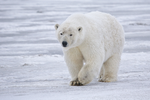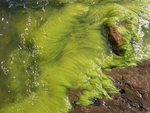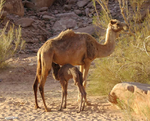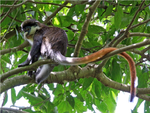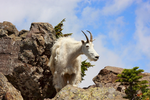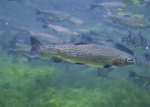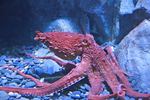Difference between revisions of "Habitat"
| (21 intermediate revisions by 2 users not shown) | |||
| Line 1: | Line 1: | ||
==Key Stage 1== | ==Key Stage 1== | ||
===Meaning=== | ===Meaning=== | ||
| − | + | A '''habitat''' is the place where a creature lives. | |
| − | + | : Singular [[Noun]]: '''Habitat''' | |
| + | : Plural [[Noun]]: '''Habitats''' | ||
===About Habitats=== | ===About Habitats=== | ||
There are lots of different '''habitats'''. Some important ones to know are: | There are lots of different '''habitats'''. Some important ones to know are: | ||
| − | : | + | : Arctic |
| − | : | + | : Coast |
| − | : | + | : Desert |
| − | : | + | : Forest |
| − | : | + | : Grassland |
| − | : | + | : Mountain |
| − | : | + | : River |
| − | : | + | : Sea |
| − | Each '''habitat''' can have [[Micro- | + | Each '''habitat''' can have [[Micro-Habitats|micro-habitats]] where the creature survives best. Like mushrooms that live on a [[tree]] in a forest, woodlice that live underneath a rotting log in the forest or meerkats that live underground in grassland. |
===Examples=== | ===Examples=== | ||
| − | : Polar bears live in | + | {| class="wikitable" |
| − | : | + | |- |
| − | : Camels live in | + | |[[File:PolarBear.png|center|150px]] |
| − | : | + | |[[File:Seaweed.png|center|150px]] |
| − | : Buffalo | + | |[[File:Camel.png|center|150px]] |
| − | : | + | |[[File:Monkey.png|center|150px]] |
| − | : | + | |- |
| − | : | + | | style="height:20px; width:150px; text-align:center;" |Polar bears live in an arctic '''habitat'''. |
| + | | style="height:20px; width:150px; text-align:center;" |The '''habitat''' for seaweed is the coast. | ||
| + | | style="height:20px; width:150px; text-align:center;" |Camels live in a desert '''habitat'''. | ||
| + | | style="height:20px; width:150px; text-align:center;" |The '''habitat''' that monkeys live in is a forest. | ||
| + | |- | ||
| + | |[[File:Buffalo.png|center|150px]] | ||
| + | |[[File:MountainGoat.png|center|150px]] | ||
| + | |[[File:Trout.png|center|150px]] | ||
| + | |[[File:Octopus.png|center|150px]] | ||
| + | |- | ||
| + | | style="height:20px; width:150px; text-align:center;" |One type of [[animal]] that lives in a grassland '''habitat''' is buffalo. | ||
| + | | style="height:20px; width:150px; text-align:center;" |Mountains are an ideal '''habitat''' for mountain goats and snow leopards. | ||
| + | | style="height:20px; width:150px; text-align:center;" |The best '''habitat''' for a trout is a lake or river. | ||
| + | | style="height:20px; width:150px; text-align:center;" |An octopus cannot survive long outside its natural '''habitat'''; the sea. | ||
| + | |} | ||
| + | |||
| + | ==Key Stage 2== | ||
| + | ===Meaning=== | ||
| + | A '''habitat''' is the type of place where creatures live. | ||
| + | |||
| + | ===About Habitats=== | ||
| + | : A '''habitat''' might not have the same conditions all the time. | ||
| + | : '''Habitats''' can change throughout the year. | ||
| + | |||
| + | *Desert '''habitats''' can have a wet season when it rains. | ||
| + | *Arctic '''habitats''' can get warmer in summer and all the ice and snow can melt. | ||
| + | *Grassland '''habitats''' can have a wet season where the flood and a dry season where the animals don't have enough water. | ||
| + | : Most '''habitats''' change temperature and rainfall in different [[Season|seasons]]. | ||
| + | : When a '''habitat''' changes the creatures that live in that '''habitat''' must be able to cope with the change. | ||
| + | : If the change is too big or happens to quickly some types of creature in that '''habitat''' may die. | ||
| + | |||
| + | ==Key Stage 3== | ||
| + | ===Meaning=== | ||
| + | A [[habitat]] is the place where an [[organism]] is best suited to live. | ||
| + | |||
| + | ==Key Stage 4== | ||
| + | ===Meaning=== | ||
| + | A [[habitat]] is the physical environment of an [[ecosystem]] where a [[community]] of [[organism]]s live. | ||
| + | |||
| + | ===About Habitats=== | ||
| + | : [[Organism]]s within a [[habitat]] are [[adaptation|adapted]] to suit that [[habitat]]. | ||
| + | : The [[organism]]s that are best suited for a [[habitat]] are more likely to survive and [[Reproduction|reproduce]]. This is called [[Survival of the Fittest|survival of the fittest]]. | ||
| + | : [[Habitat]]s can be changed by [[human]] activity. Global warming is changing the [[habitat]]s of different [[organism]]s faster than they can [[Evolution|evolve]] [[adaptation]]s to suit the new environment. | ||
| + | |||
| + | ===References=== | ||
| + | ====AQA==== | ||
| + | |||
| + | :[https://www.amazon.co.uk/gp/product/0008158754/ref=as_li_tl?ie=UTF8&camp=1634&creative=6738&creativeASIN=0008158754&linkCode=as2&tag=nrjc-21&linkId=27ad53b0283feeff7fc5ae04a9e205f365 ''Habitat, pages 64-5, 324-5, 362-3, GCSE Biology; Student Book, Collins, AQA ''] | ||
| + | :[https://www.amazon.co.uk/gp/product/1782945563/ref=as_li_tl?ie=UTF8&camp=1634&creative=6738&creativeASIN=1782945563&linkCode=as2&tag=nrjc-21&linkId=9a1d023a374038e6072f33c4f3cf808b ''Habitats, page 106, GCSE Biology; The Revision Guide, CGP, AQA ''] | ||
| + | :[https://www.amazon.co.uk/gp/product/1782946381/ref=as_li_tl?ie=UTF8&camp=1634&creative=6738&creativeASIN=1782946381&linkCode=as2&tag=nrjc-21&linkId=5ec5fc3f6429e30c1d9ab9bca2bccf93 ''Habitats, page 255, GCSE Combined Science Trilogy; Biology, CGP, AQA ''] | ||
| + | :[https://www.amazon.co.uk/gp/product/1782945954/ref=as_li_tl?ie=UTF8&camp=1634&creative=6738&creativeASIN=1782945954&linkCode=as2&tag=nrjc-21&linkId=100574c08fbbb64318256eb79ed61a76 ''Habitats, page 315, GCSE Biology, CGP, AQA ''] | ||
| + | :[https://www.amazon.co.uk/gp/product/1782945598/ref=as_li_tl?ie=UTF8&camp=1634&creative=6738&creativeASIN=1782945598&linkCode=as2&tag=nrjc-21&linkId=ad276ad49df77ab4b40ab4fd0fe09975 ''Habitats, page 83, GCSE Combined Science; The Revision Guide, CGP, AQA ''] | ||
| + | |||
| + | ====Edexcel==== | ||
| + | |||
| + | :[https://www.amazon.co.uk/gp/product/1292120193/ref=as_li_tl?ie=UTF8&camp=1634&creative=6738&creativeASIN=1292120193&linkCode=as2&tag=nrjc-21&linkId=572df39392fb4200db8391d98ae6314e ''Habitats, page 124, GCSE Combined Science, Pearson Edexcel ''] | ||
| + | :[https://www.amazon.co.uk/gp/product/1292120207/ref=as_li_tl?ie=UTF8&camp=1634&creative=6738&creativeASIN=1292120207&linkCode=as2&tag=nrjc-21&linkId=22455ff53961978667722edaa64c0be5 ''Habitats, page 176, GCSE Biology, Pearson, Edexcel ''] | ||
| − | === | + | ====OCR==== |
| − | : | + | :[https://www.amazon.co.uk/gp/product/0198359810/ref=as_li_tl?ie=UTF8&camp=1634&creative=6738&creativeASIN=0198359810&linkCode=as2&tag=nrjc-21&linkId=d768d99f1a06f7c12fab40e5aef85a55 ''Habitats, page 130, Gateway GCSE Biology, Oxford, OCR ''] |
| − | + | :[https://www.amazon.co.uk/gp/product/1782945695/ref=as_li_tl?ie=UTF8&camp=1634&creative=6738&creativeASIN=1782945695&linkCode=as2&tag=nrjc-21&linkId=ceafcc80bcad6b6754ee97a0c7ceea53 ''Habitats, page 41, Gateway GCSE Combined Science; The Revision Guide, CGP, OCR ''] | |
| − | |||
| − | : | ||
| − | : | ||
| − | |||
| − | |||
| − | |||
Latest revision as of 15:37, 11 December 2019
Contents
Key Stage 1
Meaning
A habitat is the place where a creature lives.
About Habitats
There are lots of different habitats. Some important ones to know are:
- Arctic
- Coast
- Desert
- Forest
- Grassland
- Mountain
- River
- Sea
Each habitat can have micro-habitats where the creature survives best. Like mushrooms that live on a tree in a forest, woodlice that live underneath a rotting log in the forest or meerkats that live underground in grassland.
Examples
| Polar bears live in an arctic habitat. | The habitat for seaweed is the coast. | Camels live in a desert habitat. | The habitat that monkeys live in is a forest. |
| One type of animal that lives in a grassland habitat is buffalo. | Mountains are an ideal habitat for mountain goats and snow leopards. | The best habitat for a trout is a lake or river. | An octopus cannot survive long outside its natural habitat; the sea. |
Key Stage 2
Meaning
A habitat is the type of place where creatures live.
About Habitats
- A habitat might not have the same conditions all the time.
- Habitats can change throughout the year.
- Desert habitats can have a wet season when it rains.
- Arctic habitats can get warmer in summer and all the ice and snow can melt.
- Grassland habitats can have a wet season where the flood and a dry season where the animals don't have enough water.
- Most habitats change temperature and rainfall in different seasons.
- When a habitat changes the creatures that live in that habitat must be able to cope with the change.
- If the change is too big or happens to quickly some types of creature in that habitat may die.
Key Stage 3
Meaning
A habitat is the place where an organism is best suited to live.
Key Stage 4
Meaning
A habitat is the physical environment of an ecosystem where a community of organisms live.
About Habitats
- Organisms within a habitat are adapted to suit that habitat.
- The organisms that are best suited for a habitat are more likely to survive and reproduce. This is called survival of the fittest.
- Habitats can be changed by human activity. Global warming is changing the habitats of different organisms faster than they can evolve adaptations to suit the new environment.
References
AQA
- Habitat, pages 64-5, 324-5, 362-3, GCSE Biology; Student Book, Collins, AQA
- Habitats, page 106, GCSE Biology; The Revision Guide, CGP, AQA
- Habitats, page 255, GCSE Combined Science Trilogy; Biology, CGP, AQA
- Habitats, page 315, GCSE Biology, CGP, AQA
- Habitats, page 83, GCSE Combined Science; The Revision Guide, CGP, AQA
Edexcel
- Habitats, page 124, GCSE Combined Science, Pearson Edexcel
- Habitats, page 176, GCSE Biology, Pearson, Edexcel
